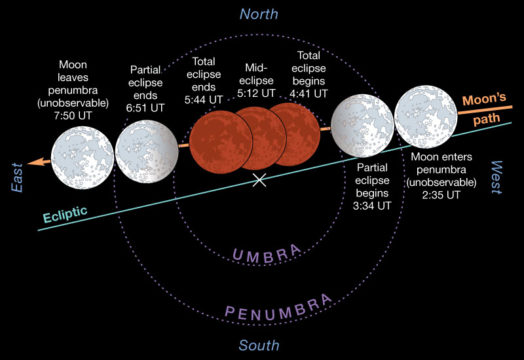Only Total Lunar Eclipse for 2019 Visible From Here This Month

Photo Credit: Leah Tiscione / Sky & Telescope
The only total lunar eclipse for 2019 will be visible from the continental United States, including Maryland, on the night of Sunday-Monday, January 20-21. More about that later, but first some late breaking local news from way beyond Pluto in our solar system’s Kuiper Belt.
On New Year’s Day, NASA’s New Horizons spacecraft flew past a small icy dwarf world far away from Earth. You may recall back in 2015, New Horizons was the first spacecraft to encounter the planet Pluto. Meantime New Horizons has continued traveling outbound.
About a half hour after 2019 began in the eastern time zone on January 1, New Horizons passed by an object officially known as 2014 MU69. More informally the object is known as Ultima Thule (pronounced Too-lee). At the time of the encounter, Ultima Thule was more than four billion miles (6.5 billion kilometers) from the earth.
New Horizons discovered that Ultima Thule is not one but two round objects, in contact with each other. The smaller body is sitting on top of the larger, much like a snowman made with two big snowballs. But Ultima Thule is much colder than a snowball as its surface temperature is believed to hover around -400°F!
I call it “local news” because the project is managed and controlled from The Johns Hopkins University Applied Physics Laboratory in Laurel. New Horizons left Earth in 2006.
Now for this month’s total lunar eclipse – the only total lunar eclipse visible anywhere in the world during 2019. Just to review, a total lunar eclipse happens when the moon, in orbit around the earth, passes through the shadow of the earth cast by the sun. It can only happen during full moon and if the moon passes precisely through a line connecting Earth and sun.
There are two concentric shadows cast by the earth. The outer is penumbral and the inner is umbral. The umbral shadow is the darker of the two. The eclipse has three distinct phases – penumbral, partial, and total eclipse. The penumbral eclipse starts when the moon begins to enter the penumbral shadow at 9:35 p.m. EDT on Sunday, January 20th. You probably won’t notice initially, but by the time the partial phase begins, some graying or darkening will become obvious.
The partial eclipse starts when the moon begins to slip into the earth’s umbra, at 10:34 p.m. EST. From this point on, the moon will dramatically begin to darken as the umbra sweeps over it. For me, this is the most interesting part: Watching the creeping dark shadow slowly engulf the moon.
At 11:41 p.m., once the moon is completely inside the umbra, total eclipse begins. During this time, the moon will probably appear orangish-red to brown. This ruddy color is an effect caused by sunlight being refracted through the earth’s atmosphere from all the sunsets and sunrises happening at the instant of observation. Mid-eclipse is at 12:12 a.m. EST Monday, January 21.
Totality for this eclipse lasts 63 minutes, ending at 12:44 a.m. EST as the moon begins slipping out of the umbra and back into the penumbra. Once more, the partial eclipse resumes. Partial eclipse ends when the moon escapes the umbra completely at 1:51 a.m. EST. The penumbral eclipse resumes until the moon leaves the penumbra at 2:50 a.m. EST and the moon once again appears full. At what time can you no longer detect any of the earth’s shadow falling on the moon?
Event times included in this article are from Sky and Telescope magazine.
As discussed last month, comet 46P/Wirtanen became an interesting object as it passed only 7.2 million miles from earth in December. Unfortunately, the weather did not cooperate with the Westminster Astronomical Society’s (WASI’s) public efforts to share the comet. However, a photo of the comet taken from Carroll County is currently posted on the Marstown.org web site.
WASI’s next happy hour star party at the Milkhouse Brewery is scheduled for January 11, from 5-9 p.m. The telescope observing is free although weather permitting. The brewery is located at 8253 Dollyhyde Rd, near Mt Airy though across the county line in Frederick County near Libertytown.
–Curt Roelle
